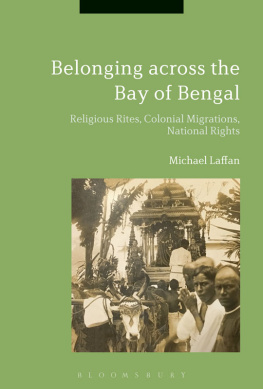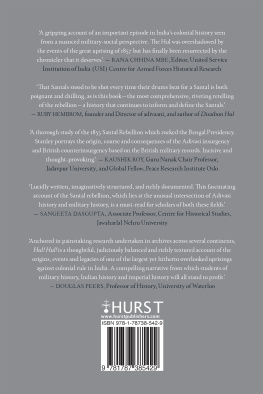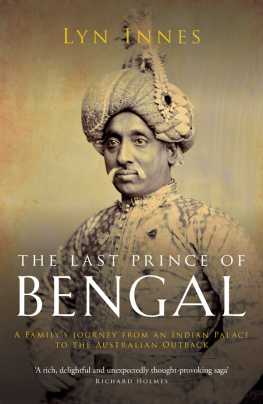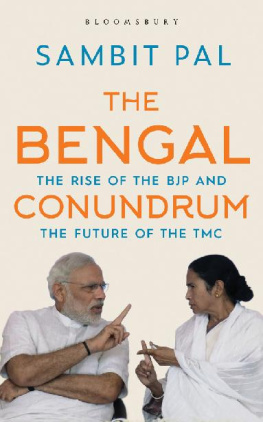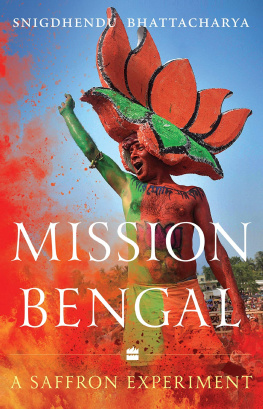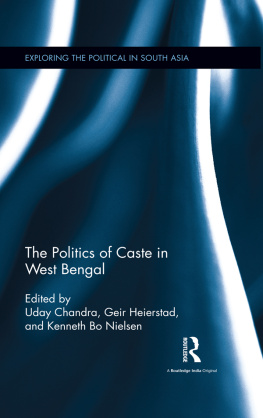Belonging across the Bay of Bengal
Belonging across the Bay of Bengal
Religious Rites, Colonial Migrations,
National Rights
Edited by Michael Laffan
Bloomsbury Academic
An imprint of Bloomsbury Publishing Plc

Every effort has been made to trace copyright holders and to obtain their permission for the use of copyright material. The publisher apologizes for any errors or omissions and would be grateful if notified of any corrections that should be incorporated in future reprints or editions of this book.
I would like to give warm thanks to the many friends and colleagues who have helped bring this book to fruition. Even if their papers are not included here, their contributions at our workshops were invaluable in charting its final shape and for seeing the issue of belonging as being so central. I am particularly grateful to my key coconspirators over these last years, Nira Wickramasinghe and Bhavani Raman, and to the Princeton Institute for International and Regional Studies, the International Institute for Asian Studies, and the Mellon Foundation for their invaluable support. Finally, I am very thankful for the cheerful and speedy work of Emma Goode at Bloomsbury, and the very generous reviewers who offered excellent suggestions for this books improvement. Needless to say, all remaining errors are very much my own.
ANRI | Arsip Nasional Republik Indonesia |
BLT | The Burma Law Times |
CO | Colonial Office, National Archives, Great Britain |
EFEO | cole franaise dExtrme-Orient |
IA | The Law Reports, Indian Appeals |
IOR | India Office Records and Private Papers, British Library |
ISEAS | Institute of Southeast Asian Studies |
JMBRAS | Journal of the Malayan Branch of the Royal Asiatic Society |
KAB | Western Cape Provincial Archives and Records Service, Republic of South Africa |
KITLV | Royal Netherlands Institute of Southeast Asian and Caribbean Studies, Leiden |
LBR | Lower Burma Rulings |
MAS | Modern Asian Studies |
SLNA | Sri Lanka National Archives |
SFP | The Singapore Free Press |
SSLR | Straits Settlements Law Reports |
SSR | Straits Settlements Records (Singapore National Archives) |
ST | The Straits Times |
Michael Laffan
Princeton University
The Bay of Bengal is recognized today as a crucial political arena, yet for many of the people found in its waters it is merely a great sea.
Even so, the Bay of Bengal remains a space of danger and hope for those left in the wake of the vapor trails of so many migrants or outside the calculations of grand strategists charting the rise of India and China.
It is this history that our volume maps out. Linking with Amriths work that has rendered the Bay much less the neglected sea characterized by Rila Mukherjee a decade ago, this book brings greater attention to bear on a continuum of Buddhist connectivities and tales of Muslim sanctity alike that were intertwined with equally deep histories of families alternatively scattered and held in place by the rhythm of currents, winds, andultimatelymodern timetables. It moreover weaves in the dreams of fin de sicle pan-Asianists and questions the colonial designations of so many sojourners as Moors, Tamils, or yet Malays before showing how such identities impacted political claims as empires ebbed and nations rose.
Viewed over the longue dure, there has been a profound shift in agency for Muslims across the Indian Ocean over the past centuries. This is ironic as, historically speaking, scholars have so often cast its reaches as having been shaped by Muslim trade and law, often citing the examples of Ibn Battuta (130468), a Moroccan traveler of the fourteenth century, or the navigational treatises of the Gulf-born Ahmad ibn Majid (1421ca. 1500), who ranged as far as the court of Melaka, on the Malay Peninsula.
This is not to say that the Indian Ocean was ever the exclusive domain of Islamic culture before the dawning of the Vasco da Gama Epoch, as the Travancore-born diplomat and historian K. M. Pannikar (18941963) once termed it. Indeed the Estado da India depended both on (often Parsi) Gujarati capital and even tactical alliances with Muslim polities, as when Malindi jousted with Mombasa in East Africa or Johor tussled with Aceh after Melakas capture by the Portuguese in 1511.
Whether they were allied to the Portuguese or not, the rulers of the shores and hinterlands of the Bay of Bengal would demonstrate their commitments to one faith or
While both Gaya and Nalanda are located in the modern-day Bihar, many travelers would once have deemed it merely part of Bengal or simply Bharatas India is known in Hindi, much as the Malay word for west is barat. With the decline of Buddhism in India in the face of Brahmanic and Islamic competition alike, and then with the ebbing of Chola power at sea, Lanka, which boasted its own cutting of the Bodhi tree at the city of Anuradhapura, would become the most important site for a networked practice generally known, as Anne Blackburn reminds us in our opening chapter, as Southern Buddhism. Indeed, Lankas kingdomsand most especially the upland polity of Kandy (14691815)would see numerous visits from monastic delegates from Southeast Asia eager to return to their royal patrons with copies of sacred Pali-language texts.
Equally Mecca, the site of the great annual pilgrimage, or hajj, would draw delegates from numerous courts in the island world anxious to return with an affirmation of Islamic authority already invoked by their cosmopolitan use of the Arabic script. Such affirmations were strengthened by marital linkages to prominent scholars.
The rise of Western power did nothing to affect the importance ascribed to such journeys in many imaginaries, even if, by the nineteenth century, many Asian rulers would be reduced to the status of pensioners in gilded palace cages or, worse, exile. The expansion of Western influence arguably affirmed the centrality of these itineraries and redefined who had the right to speak for religion, as European shipsoften Dutch and then increasingly Englishcame to facilitate the long-distance transitions between South and Southeast Asia in the eighteenth century. Moreover, following the British takeover and development of so many coastal hubs in southern Asiamost notably Penang (1786), Colombo (1795), Singapore (1819), Melaka (1824), and Rangoon (1852)one sees the emergence of lay-driven styles of religiosity with attendant definitions of belonging in flux across the region.
Such definitions would become all the more contentious with the widespread deployment of southern Indian laborers and venture capitalists into the expanding fields of export agriculture. This was particularly so in British Ceylon from the 1830s, and then Malaya in the 1870s, which drew many officials from that island, together with sepoys recruited from the north of India.
Yet as Torsten Tschacher emphasizes in this volume, the uncritical use of such terms as Tamil (like Malabar before it Moreover, one finds in the nineteenth century a whole host of identifications for southern Indians increasingly freighted with pejorative meanings. Consider the laboring Klings of Malaya, who perhaps owe their name to the ancestral kingdom of Kalinga in modern-day Orissa, or yet the Chulias and Chettiar bankers who, with their connections back to Nagore, became the primary financial intermediaries for Indian kin and natives alike (and the most prominent funders of Thaipusam in the Straits Settlements). Equally one can point, as Wickramasinghe does in her chapter, to the rising hostility among self-imagined Aryan Sinhalese in Lanka in the 1930s against migrants identified as Malayalees and Cochins.
Next page
